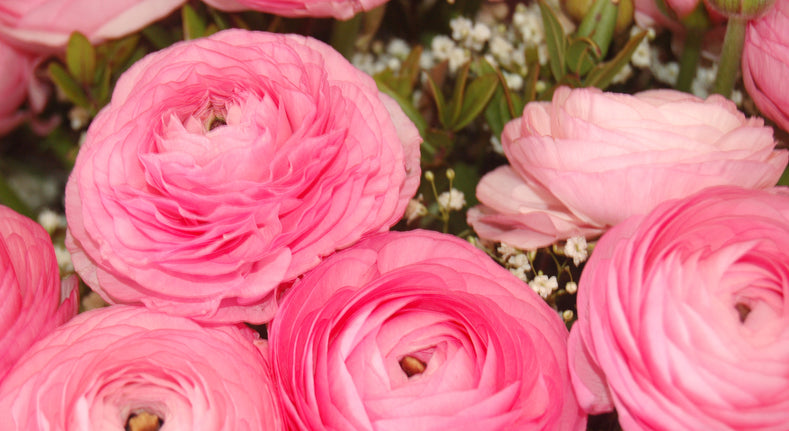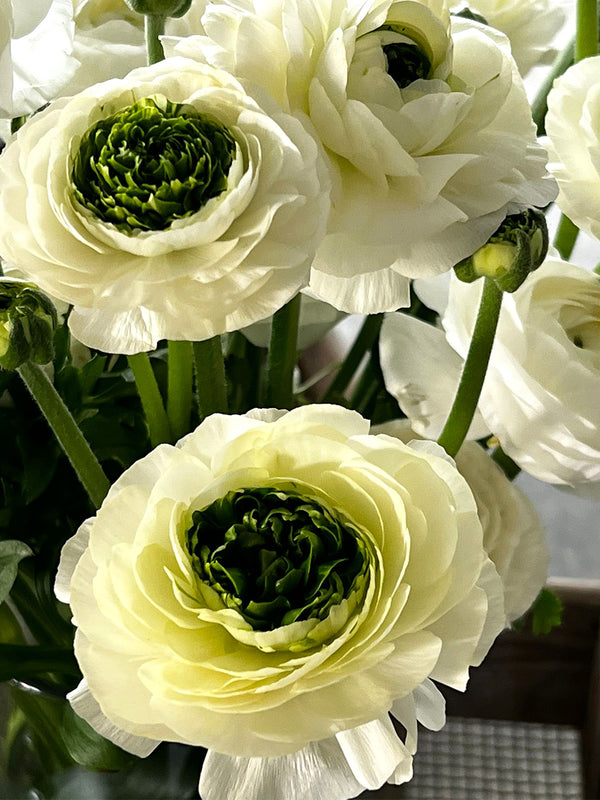When to Plant Italian Ranunculus?
Italian Ranunculus bulbs are best planted in regions with mild winters and long, cool springs. The ideal time to plant depends on your hardiness zone:
1. Zones 8 to 10: If you reside in these zones, fall is the recommended planting time. Plant the ranunculus bulbs in Fall for blooms in late winter and early spring.
2. Zones 2 to 7: For gardeners in colder regions, it's best to plant ranunculus bulbs in late winter or early spring, once the danger of hard frost has passed. By doing so, your blooms will appear in late spring or early summer.
Ranunculus bulbs have the unique characteristic of being storable. If you receive the bulbs but aren't ready to plant them, you can keep them in the shipping bag at room temperature, away from direct sunlight, for up to eight months. This allows flexibility in timing your planting based on your gardening schedule or climate conditions.
Where to Plant Italian Ranunculus?
When planting ranunculus, you have the option to plant them in containers or in prepared beds. Here are some guidelines for both options:
Container Planting:
1. Choose a container that is large enough to accommodate the full-grown ranunculus plant. This allows room for the roots to spread and promotes healthy growth.
2. Ensure the container has adequate drainage holes to prevent waterlogging. Proper drainage is crucial to prevent root rot.
3. Select a spot for your container that receives full sun for at least 6 hours a day. Ranunculus thrives in sunny locations.
4. Once the danger of hard frost has passed, place the container in an area that receives full sun all day. This maximizes sunlight exposure, which is essential for the plant's growth and flowering.
Bed Planting:
1. Prepare the bed by ensuring the soil is well-draining and fertile. Amend the soil with organic matter, such as compost, to improve its quality.
2. Choose a location that receives full sun. Ranunculus plants require ample sunlight to grow and bloom properly.
3. Plant the ranunculus bulbs in the prepared bed, following the recommended planting depth and spacing. Typically, bulbs are planted 2 to 3 inches deep and spaced 6 to 9 inches apart.
4. Ensure the soil is moist after planting by gently soaking it.
Whether you choose container planting or bed planting, providing full sun exposure and well-draining soil are key factors in successful ranunculus growth and flowering.

How to Plant Italian Ranunculus?
To plant ranunculus bulbs, follow these steps:
1. Soak the bulbs in lukewarm water for two to three hours before planting. Be cautious not to oversoak them.
2. Choose well-draining soil for planting and ensure the location offers full sun exposure. Ranunculus thrives in sunny conditions.
3. Dig holes in the soil that are deep enough to accommodate the bulbs. Typically, plant them 2 to 3 inches deep. Space the bulbs 6 to 9 inches apart to allow for proper growth.
4. Place the ranunculus bulbs in the holes with the pointed ends facing downward. The pointed end is where the sprouts will emerge.
5. Once the bulbs are positioned correctly, backfill the holes with soil, covering the bulbs completely.
6. After planting, gently soak the soil to provide moisture to the bulbs and help them establish.
If you want to pre-sprout your ranunculus bulbs for earlier blooming, follow these additional steps:
1. Soak the corms (bulbs) in room-temperature water for three to four hours.
2. Fill a flat-bottomed seed tray halfway with moist potting soil.
3. Place the corms on the soil surface in the tray and cover them with more soil, ensuring they are evenly spaced.
4. Move the tray to an area with consistent temperatures of 40 to 50°F (4 to 10°C). This can be a cool indoor space or a protected outdoor area.
5. Check the corms every three to four days to ensure the soil remains moist. Remove any corms showing signs of rotting or molding.
6. After about two weeks, rootlets should start to appear. At this stage, it's time to plant the pre-sprouted ranunculus bulbs in the ground or containers, following the regular planting instructions mentioned earlier.
By pre-sprouting, you can encourage earlier blooming of your ranunculus flowers.

How to Care for Italian Ranunculus?
Caring for ranunculus plants involves some important steps. Here's how to properly care for ranunculus:1. Post-Blooming Care:
After the ranunculus plant has finished blooming for the season, it's crucial to leave the foliage in place. The leaves will continue to gather sunlight and nourish the bulbs, helping them store energy for future growth and blooming. Do not remove the foliage immediately after flowering.
2. Yellowing and Dormancy:
As the ranunculus plant enters its dormant phase, you will notice the foliage starting to yellow and die back. This is a natural process and an indication that the plant is entering a resting period. During this time, the bulbs are replenishing their nutrients and preparing for the next growing season.
3. Foliage Removal:
Once the foliage has completely yellowed and withered, you can safely remove it from the plant. Gently pull or cut off the yellowed leaves, being careful not to damage the bulbs beneath the soil.
4. Bulb Storage:
If desired, you can lift and store ranunculus bulbs for the offseason. Lift the bulbs carefully, brush off excess soil, and allow them to dry in a cool, well-ventilated area. Once they are completely dry, store the bulbs in a cool, dry, and dark place until the next planting season.
5. Watering:
While the ranunculus plants are actively growing and blooming, it's important to provide regular watering. Keep the soil evenly moist but not waterlogged. Avoid overwatering, as excessive moisture can lead to bulb rot.
6. Mulching:
Applying a layer of mulch around the base of the ranunculus plants can help retain soil moisture, suppress weed growth, and provide some insulation during colder weather.
7. Pest and Disease Control:
Keep an eye out for common pests such as aphids or snails, and take appropriate measures to control them if necessary. Ranunculus plants are generally not highly susceptible to diseases but ensure proper sanitation and good airflow to prevent any potential issues.
By following these care instructions, you can help maintain healthy ranunculus plants and ensure their vigor for future seasons of beautiful blooms.
How to Store Italian Ranunculus?
To store ranunculus bulbs (corms) properly, follow these steps:
Dried Corms:
If you receive ranunculus bulbs in a dry, dormant state and you are not ready to plant them immediately, store them in the bag they came in. Keep the bag in a cool, dry place at room temperature, away from direct sunlight. A pantry or a storage room works well for this purpose. Make sure the bulbs are not exposed to moisture or extreme temperatures.
Lifted Corms:
If you have already lifted the ranunculus corms from the ground and need to store them, follow these instructions:
1. Prepare the Corms:
Remove any excess soil from the corms gently, taking care not to damage them. Leave them to dry in a well-ventilated area for a few days until they are completely dry.
2. Use Dry Moss:
Fill a mesh bag (such as a mesh onion bag) with dry moss, such as peat. The moss helps provide a dry environment and prevents the corms from drying out excessively.
3. Place Corms in Moss:
Put the dried ranunculus corms into the mesh bag filled with dry moss. Ensure the corms are evenly distributed and not touching each other.
4. Store in Cool, Dry Location:
Find a cool and dry place to store the mesh bag containing the corms in dry moss. The ideal temperature for storage is around 40 to 50°F (4 to 10°C). A garage, basement, or cellar can be suitable storage locations.
By following these storage guidelines, you can preserve the quality and viability of ranunculus corms for an extended period, ensuring they remain in good condition until you are ready to plant them.


